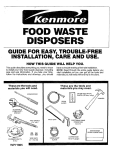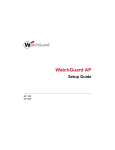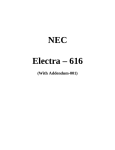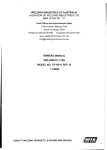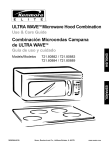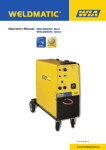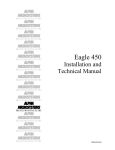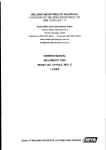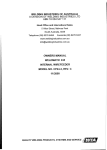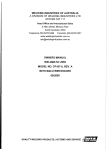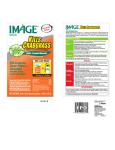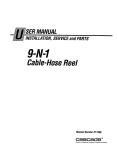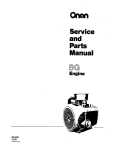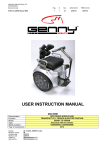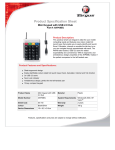Download CP109-1 Weldmatic 215S with W52 Feeder Manual
Transcript
WELDING INDUSTRlES OF AUSTRALIA A DIVISION OF WELDING INDUSTRIES LTD ABN 18 004 547 A 7 I I Head Office and International Saies 5 Allan Street, Melrose Park South Australia, 5039 Telephone (08) 8276 6494 Facsimile (08) 8276 6327 w.weldingindustries.corn.au [email protected] OWNERS MANUAL WELDMATIC 215s MODEL NO. CPqO9-I, REV. A l112000 ~ ~ QUALITY WELDING PRODUCTS, SYSTEMS AND SERVICE Page 2 I WELDMATIC 2j5S MANUAL The information contained in this manual is set out to enable YOU to properly maintain your new equipment and ensure that you obtain maximum operating efficiency . Please ensure that this information is kept in a safe placefor ready reference when required at any future time . When requesting spare parts, please quote the model and serial number of the machine and part number of the item required. All relevant numbers are shown in lists contained in this in supplying the manual. Failure to supply this information may result in unnecessary deiays correct parts. SAFETY Before this equipment is put into operation, the Safe Practices section at the back of the to avoidpossibleinjurydue to misuse or manual must be read completely. Thiswillhelp . improper welding applications CONTENTS Sec.1 ...................... Introduction ......................................................... P.3 .. Sec.2 ...................... Recelvlng............................................................. P.3 Sec.3 ...................... Specifications ...................................................... P.4 ........................................ P.5 Sec.4 ...................... Power Source Controls Installation ........................................................... P.6 Sec.5 ...................... ..... P.6 5.1 .................. Connection To Electrical Mains Power Supply 5.2 .................. Fitting The Gas Bottle.......................................... P.7 5.3 .................. Fitting Remote Wirefeeder ................................... P.7 5.4 .................. Fitting The Gun Cable......................................... P.7 5.5 .................. Fitting The Consumable Wire.............................. P.7 ........................... P.7 5.6 .................. Feeding The Consumable Wire ........................ P.8 5.7 .................. Output Voltage Polarity Selection Sec.6 ...................... Normal Welding Sequence .................................. P.9 P.9 6.1 .................. Weld Start ........................................................... P.9 6.2 .................. Weld End............................................................. Basic Welding Information ................................... P.9 Sec.7 ...................... 7.1 .................. Choice Of Shielding Gas..................................... P.9 7.2 .................. Shielding Gas Flow Rate ..................................... P.9 7.3 .................. Establishing A Weld Setting ................................. P.9 7.4 .................. Gun Position........................................................ P.10 Sec.8 ...................... General Maintenance.......................................... P . l l Sec.9 ...................... Trouble Shooting................................................. P.12 ............................................. .14 P Information Service Sec.10.................... Sec.1l.................... Parts List- Power Source Assembly .................... P.16 Sec.12.................... Parts List - Remote Wirefeeder........................... P.18 Sec.1 3.................... Parts List- Wire Drive Assembly ......................... P.19 Sec.14 .................... Parts List- Interconnecting LeadKit ................... P.10 P.21 Sec.1 5.................... Parts List- Gun Cable Assembly........................ Sec 16.................... Safe Practices..................................................... P.22 FIGURES Fig.1 ....................... Fig.2 ....................... Fig.3 ....................... Fig.4 ....................... Fig.5 ....................... Fig.6 ....................... Fig.7. ...................... Fig.8 ....................... Fig.9 ....................... Fig.10 ..................... Fig.11 ..................... Fig.12 ..................... Fig.13 ..................... Fig.74 ..................... Fig.15 ..................... Power Source Control Locations ......................... Connection of Supply Cable ................................ Remote Wirefeeder Connection.......................... Positive Wire Connection ..................................... Negative Wire Connection ................................... "6ood" Weld ........................................................ "Bad" Weld .......................................................... Gun Position........................................................ GP109-10 Control Board..................................... 6P-I09-0 Circuit Diagram..................................... Power Source Assembly ..................................... Remote Wirefeeder............................................. Wire Drive Assembly ........................................... AM297 Interconnecting Lead Kit .......................... Gun Cable Assembly ........................................... P.5 P.6 P.7 P.8 P.8 P.10 P.10 P.10 P.14 P.15 P.17 P.18 P .19 P.20 P.21 WELDMATIC 215s MANUAL Page 3 l. INTRODUCTION Gas Metal Arc Welding (G.M.A.W.) is a welding process where a consumable wire is fed by motor driven drive rollers to a welding gun, and where welding current is supplied from the welding power source. The welding arc is struck between the work piece andthe end of the wire, which melts into the weld pool. The arc and the weld pool 2re shielded by gas flow from the gun, or in the case of "self shielded" wires, by gases generated by the wirecore. By selection of the correct wire composition, diameter and shielding gas,G.M.A.W. can be used for applications ranging from sheetmetal to heavy plate, and metals ranging from carbon steel to aluminium alloys. The WELDMATIC 215s has been designedto be used with consumable wiresin the range from 0.6mm to 1.2mm diameter. The smaller wire sizes are used when welding lower at currents, such as sheet-metal applications. Increasing the wire diameter permits higher welding currents to be selected. AcommonapplicationofG.M.A.W.isforweldingMildSteel. In this application,aMild Steel solid consumable such as AUSTMIG ES6 is used with a shielding gas of Argon mixed with 5 - 25% Carbon Dioxide.Alternatively,Flux-coredconsumablesareavailable in bothgas shielded, and 'gasless' self shielding types. Stainless steel and Aluminium can be welded with G.M.A.W. using the correct consumable wire and shielding gas. 2. RECEIVING Check the equipment received against the shipping invoice to make sure the shipment is complete and undamaged. If any damage has occurred in transit, please immediately notify your supplier. The CPI 09-0 package contains; WELDMATIC 215s Power source. BEXT2-4E21OAE BERNARD Gun cable, 3 metre, Euro connector. WGAC24 Regulator and Flow gauge. (Argon) (This) Owners Manual. WELDMATIC 275s MANUAL Page 4 3. SPECIFICATIONS Manufactured to Australian standard AS1 966.1 "l985 Rated to ISO/IEC 60974-1 ( I O minute duty cycle) - WELDING INDUSTRIES of AUSTRALIA We!drrratic 2 15s Made in Australia b 'I I "_ I RATED TO ISOAEC60974-1 l- I e I N8031 I 1 COOLING AF Under ISO/IEC 60974-1, duty cycle is defined as the ratio of arcing time to an operating time of 10 minutes, expressed as a percentage. Page 5 WELDMATIC 215s MANUAL - 4. POWER SOURCE CONTROLS WIRE SPEED CONTROL SPOT TIME CONTROL INTERVAL CONTROL OVERLOAD INDICATOR POWER ON INDICATOR FINE VOLTAGE CONTROL COARSE VOLTAGE CONTROL I - \ 0 I / 9 IW@V FIGURE l, POWER SOURCE CONTROL l.POWER ON INDICATOR This is illuminated when electrical mains power is connected to the welding power source. l 2. COARSE VOLTAGE CONTROL This switch provides Coarse adjustment of the Output Welding Voltage over three ranges. 3. FINE VOLTAGE CONTROL This switch provides Fine adjustmentof the Output Welding Voltage overthree ranges. 4. WIRE SPEED CONTROL This control provides adjustment of the wirefeed speed. Rotating the dial in a clockwise direction will increase the wirefeed speed, thereby increasing the welding current. 5. SPOT TIME CONTROL When operating the machine in Spot Weld mode, this control will vary the spot weld time. Rotating the dial in a clockwise direction will increase the spot weldtime, in the range 0.4 - 3.0 seconds. If the Spot Weld mode is not required this feature may be turned off by rotating the control anti-clockwise until it ‘clicksointo the minimum position. 6. INTERVAL CONTROL When operating the machine in Cycle Arc mode this control sets the period between welds. Thespot time controlsetstheweldingperiod.Rotatingthe dial in aclockwise direction will increase the interval time, in the range 0.4 - 1.8 seconds. If the Cycle Arc mode is not required this feature may be turned off by rotating both controls fully anti-clockwise. 7. OVERLOAD INDICATOR This is illuminated when the welding load exceeds the operating duty cycle. In this event the machine will not deliver welding current until the machine has cooled sufficiently. The overtemperature thermostats will reset automatically - do not switch the machine off as the coaling fan will assist the resetting of the thermostats. WELDMATIC 215s MANUAL Paqe - 6 5. INSTALLATION 5.1 CONNECTION TO ELECTRICAL MAINS POWER SUPPLY 1 NOTE. All electrical work shall only be undertakenby a qualified electrician. I I The WELDMATIC 215s is factory fitted with a 3 metre, 3 core 50/8.25 Heavy Duty PVC mains power supply cabie with moulded 3 pin, 15 Amp, Single Phase plug. A 15 Amp plug and socket is recognisable by a wide Earth pin. Power Supply authorities to a 240 Volt, 15 Amp require that equipmentfitted with a 15 Amp plug shall ONLY be connected power point. DO NOT modifythe plug. The minimum capacity ofthe mains wiring and power outlet supplying a welder selected is according to the effective primary current of the machine. The effective primary current for a Weldmatic 215s is 16 Amps. Theminimumrecommendedcircuitbreakerrating for aWeldmatic 215s is20Amps. from the Note : The tripping time of a typical 20A circuit breaker may limit the duty cycle available Weldmatic 215s. A higher rated circuit breaker can be selected, but the mains wiring capacity must be increased to suit. The current rating of the mains cable depends on cable size and method of installation. Refer to AS/NZS 3008.1, Table 9. If it becomes necessary to replace the mains flexible supply cable, use only cable with correct current rating. Access to the machine supply terminals is gained by removing the power source left hand side panel. (Power source viewed from front). Pass the cable through the bushfitted to the machinebackpanel.Thecablesare terminated at the terminal block as shown in Figure 2. Tighten the cable clamp leaving just sufficient slack in the cable so that the terminated wires are not in tension. BROWN BLUE TERMINAL BLOCK CABLE 3 CORE POWER CABLE YELLOW CONNECTION BUSH FIGURE 2. CONNECTION OF SUPPLY FLEXIBLE CABLE l WIRE l WELDMATIC 21 SS MANUAL Page 7 5.2 FITTING THE GAS BOTTLE Depending on configuration of the cylinder to be used, the gas flowmeter / regulator may fitting. DONOTapplyany be fitted directlyto the cylinder, or in conjunctionwithanelbow grease to these joints, and tighten the nuts securely. Fit the end of the gas inlet hose from the back of the machine to the connector supplied with the flow regulator, and secure withthe clamp also supplied. 5.3 FITTING REMOTE WIREFEEDER The W52-0 remote wirefeeder is connected to the WELOMATIC 215s power source using an AM297 extension lead kit. The connection details are shown inthe diagram below. GUN CABLE CONNECTOR - BLACK BLACK BLUE w RED WFEEDER 5 2 4 WIRE I LEAD AM297 KIT I WELDMATIC 215s POWER SOURCE FIGURE 3. REMOTE WIREFEEDER CONNECTIONS 5.4 FITTING THE GUN CABLE The BERNARD BEXT2-4E21OAE gun cable is equipped with a 'Euro' wirefeeder connector which incorporates all required connection points tothe gun cable for welding current, shielding gas and gun switch control. To attach the gun cable to the wirefeeding mechanism, engage the mating parts of the male and female Euro connectors, then rotate the locking ring clockwise to firmly secure the connection. 5.5 FITTING THE CONSUMABLE WIRE The quality of the consumable wire greatly affects how reliably a gas metal arc welder will operate. For best results when welding mild steel, we recommend quality WIA AUSTMIG ES6. Dirty, rusty or kinked wire will not feed smoothly through the gun cable and will cause erratic welding.Deposits from the wirewillclog the gun cable liner requiring it to bereplaced prematurely. Place the spool of welding wire onto the spool holder. The location pin should mate with a hole provided on the wirespoolbody.Fit the spool retaining 'R' clip supplied. Check the adjustment of the spool brake, which should be set to prevent over-run of the wire spool at the end of a weld, without unduly loading the wirefeed motor. The braking can be adjusted by the Nyloc nut using a 15/16" AF or 24mm socket wrench. 5.6 FEEDING THE CONSUMABLE WIRE With reference to Figure 12, release the pressure screw (6), and rotate the pressure arm (4) to the open position. The end of the welding wire can now be passed through the inlet guide (1l), over the bottom driven roller (g), and into the output wire guide tube. Check that the drive roller groove iscorrect for the wire in use. The appropriate size is stampedon the visible side of the installed roller. Check also that the correct size contact tip is fitted at the gun end. Drive roller and tip details are available in Section 11 of this manual. Return the pressure arm to the closed position and, adjust the pressure screw to provide sufficient clamping ofthe drive rolls drive to achieve constantwirefeed. Do not over tighten. WELDMATIC 215s MANUAL Paae 8 v ~~ ~ 5.7 OUTPUT VOLTAGE POLARITY SELECTION. ThedesignoftheWELDMATIC 215s allowsexternalselectionof polarity - positive wire or negative wire. the output voltage 5.7.1 POSITIVE WIRE Most solid wireG.M.A.W. is carriedoutwith the work piece Negative and the welding consumable wire Positive. To set the machine for this condition, insert the ‘WORK lead plug into the(-) output socket on the front of the power source. Insert inter-connecting ‘WELD’ iead plug into the (+) output 4 below. socket on the front of the power source. See Figure 5.7.2 NEGATIVE WIRE Some ‘self-shielded’ flux cored consumables are intended to be operated with the work piecePositiveand the consumablewireNegative.Refer to themanufacturersdata for the particular consumableto be used. To set the machine for this condition, insert the ‘WORK’ lead plug into the (+) output socket on the front of the power source. Insert inter-connecting ‘WELD’ lead plug into the (-) output socket on the front of the power source. See Figure5 below. n “ WORK LEAD FIGURE 4. POSITIVE WIRE W LEAD FIGURE 5. NEGATIVE WIRE Page - 9 WELDMATIC 215s MANUAL 6. NORMAL WELDING SEQUENCE 6.1 WELD START Closing the welding gun switch initiates this sequenceof events: The gas valve is energised, gas flow commences; The power source triac function is initiated. Welding voltage is applied between the work piece andthe consumable wire; The wire drive motor is energised. Wirefeed commences and the arc is established. 6.2 WELD END Releasing the gun switch initiates this sequence of events: The wire drive motor is de-energised, and is dynamicaily braked to a stop; The power source triac function is de-energised; C The gas valveis de-energised and the flow of shielding gas ceases. 7. BASIC WELDING INFORMATION 7.1 CHOICE OF SHIELDING GAS The choice of shielding gas is largely determined by the consumable wireto be used. Many proprietary shielding gas mixtures are available. The recommended shielding gases for use with the WELDMATIC 215s are : Mild Steel .................................... Argon + 5 to 25% Carbon Dioxide; Aluminium ................................... Argon; Stainless Steel ............................ Argon + 1 to 2% Oxygen. Consult your gas supplierif more specific information is required. 7.2 SHIELDING GAS FLOW RATE In G.M.A. welding, one of the functions of the shielding gas is to protect the molten weld pool from the effectsofoxygen in the atmosphere.Without this protection the welddeposit becomes 'honeycombed' in appearance, an effect whichis described as weld porosity. In draft-free conditions the gas flow rate required to give adequateprotection is typically 10 litredmin. In situations where drafts cannot be avoided,it may be necessary to increase this rate and/or to provide screeningof the work area. Weld porosity can alsobe caused by air entering the gas streamthrough a damaged hose, of spatter. loose gas connection, orfrom restriction in the nozzle, such as from excess build-up 7.3 ESTABLISHING A WELD SETTING Once the consumable wire type, wire size and shielding gas have been chosen, variables which are adjusted in order to obtain a stable arc are; Wirefeed speed, Welding arc voltage. the two WELDMATIC 215s MANUAL Page 10 The wirefeed rate determines the welding current; increasing the feed rate increases the current, and decreasing it decreases current. The selected wirefeed rate must be matched with sufficient arcvoltage; an increase of wirefeedrate requires an increaseof arc voltage. If the voltage is too low the wire will stub and stutter, and there will not be a steady arc. If the voltage is too high the arc will be long with the metal transfer within the arc occurring as a series of large droplets. IMPORTANT: Do not operate the Voltage Control switches during welding. The welding current should be chosen to suit the thickness of the metal to be welded. It is important to check that the deposited weld provides sufficient strength to suit the application. A "good" weld will have the characteristics illustrated in Figure 6. The weld has penetrated into the parent metal, fusing the root of thejoint where the two plates meet, andthe weld blends smoothly intothe side walls. A "bad" weld is shown in Figure 7. The weld has not penetratedthe joint root, and there is the arc poor side wall fusion.Thislackoffusionwouldnormallybecorrectedbyincreasing voltage, orby increasing both wirefeed rate and arc voltage to achieve a higher current weld setting. L L, FIGURE 6. "GOOD" WELD FIGURE 7. "BAD" WELD 7.4 GUN POSITION For "down hand" fillet welding, the gun is normally positioned as shown in Figure 8 below with the nozzle end pointing in the direction of travel. l & M FIGURE 8. GUN POSlTlQN WELDMATIC 215s MANUAL Page 11 8. GENERAL MAINTENANCE I Before removing the machine cover,ENSURE that the unit is disconnected from the mains power supply. When the unit is energised LETHAL VOLTAGES are present onthe electrical components enclosed. I I DUST Care should be taken to prevent excessive buiid-up of dust and dirt within the weiding to the prevailing conditions, power source. It is recommended that at regular intervals, according the machine covers and enclosed wirefeeder covers be removed and any accumulated dust be removed by the use of dry, low pressure compressedair, or a vacuum cleaner. WIREFEED In order to obtain the most satisfactory welding results from the G.M.A.W. process, the wirefeed must be smooth and constant.It is therefore importantto observe the following points; Keep the gun cable liner clear of dust andswarf build-up. When replacement becomes necessary, fit only the correct liner to suit the gun cable model. See page19. The build-up of dust in a cable liner can be minimised by regular purging of the liner with dry compressed air. This may be conveniently done each time the wire spool is replaced. Replace the welding tip as it becomes worn. Keep the wire drive mechanism clean. Periodically check the drive rollers for wear and for free rotation. Check that the consumable wire spool holder rotates smoothly and that the braking action is not excessive. This also may be conveniently done each time the wire is replenished. Paae 12 WELDMATIC 2q5S MANUAL. Y 9. TROUBLE SHOOTING FAULT REMEDY Power source has nopower, ie. l 1) power !ight is off Turn on mains sulsolva switch I . I Check mains voltage, fuses or circuit breaker 2) fans are not running Check all primary connections in power source andin primary plug l I I Power source hasno output but : Check all connections to CP109-10 control boardin power source 1) power light is off Replace CP109-10 control board 2) fans are running I l I Power source hasno output and I Power source overheated. Allow thermostatsto cool with fans on when gunswitch is After cooling, if problem still persists, check rectifier thermostat no wirefeed closed but: and transformer thermostatfor open circuit. Replace if faulty 1) power light is on Check all connections to CP109-10 control boardin power source 2) overload light is on 3) fans are running Power sourcehas nooutput and Gun switch circuit incomplete. Check gun switch for continuity with no wirefeedwhen gun switch is ohm meter when switchis pressed. Replace if faulty closed but: Gun switch circuit incomplete. Check the 2 pin receptacles in euro 1) power light is on adaptor are making contact with the2 pins fromthe gun cable. 2) overload light is off Check all connections to CP109-10 control boardin power source 3) fans are running Replace CP109-10 control board Power source has liveoutput all Check triac in rectifier assembly of power source. Switch off mains the timewhen mains power is power and disconnect yellow wire from gate terminal of triac. applied and gun switch is off Switch on mains power andif output is still live, replace triac Replace CP109-10 control board Power source haslow weld Check welding circuit is making good electrical connection Check all cable connectionsin power source for hot spots. output Power source hasno weld output Check all cable connectionsto coarse and fine switches variation when coarseand fine Check coarse andfine switches are operated I Replace if faulty Switches I l Mains fuses blowor circuit Check welding transformerfor a primary fault to earth. breaker trips instantly when Replace if faulty mains voltage is applied Check fan in power source for short circuit or fault to earth Replace if faulty Check welding transformerfor shorted turns. Replace if faulty breaker trips instantly when Check rectifier for shorted diodes. Replace if faulty I T-" I Check that therecommended fuseor circuit breaker rating has been breaker trips when welding I used. Consider upgrading to larger fuse circuit or breaker & wiring. I I WELDMATIC 215s MANUAL Page 13 v TROUBLE SHOOTING cont. UNSATISFACTORY WELDING PERFORMANCE AND RESULTS REMEDY FAULT Erratic arc characteristics Check aun liner for build UD of dirt or blockaae. Replace if dirtv caused by poor wirefeed Check if wire is slipping on roller assembly. Replace feed roll if worn Check if there is too much drive roller Dressure onwire ~ ~~ Check SDOO~holder is rotatina smoothlv Check that gun liner is not too short and is fitted correctly. Refer to page 19 for fitting instructions. Constant poor arc Check correct polarity has been selected for work and weld cables. characteristics Refer to page 8 Check shieldina aas is correct for the consumable in use Check welding circuit is making goodelectrical connection Check all connections in powersource and wirefeeder for hot spots I I Porosity in weld caused by I lack of shielding gas I I l Check gas solenoid. Replace if faulty Check that the correct gas flow rate has been set Check for leaks in gas hose. Replace if leaking Check for leaks in gun cable, eg. O-rings. Replace if leaking Check nozzle is firmly attached to gun and that no air is being I I drawn in WELDMATIC 215s MANUAL Page - 14 I O . SERVICE INFORMATION. CP109-10 CONTROL BOARD The CP109-IO Control board provides the following functions. Welding transformer ON l OFF control. Wirefeed motor ON / OFF control. Speed control of the wirefeed motor. Braking of the wirefeed motor at end of weld. Spot-weld timer. Interval timer. Gas solenoid valve ON l OFF control. Triac ON l OFF control, phase selectedto minimise transformer inrush current. Triac protection by output short circuit detection. Connections to the board are detailed inthe drawing below. The circuit is factory adjusted to provide a maximum drive roller speed of 160 rpm. MAXIMUM SPEED CAL'BRAT'oN 7 ACTIVE 24OVAC THERMOSTAT NEUTRAL 24OVAC THERMOSTAT OUTPUT TERMINAL +VE OUTPUT.TERMINAL -VE SECONDARYTRANSFQRMER WIREFEED MOTOR +VE WIREFEED MOTOR -VE FIGURE 9. CPI 09-10 CONTROL BOARD WELDMATIC 215s MANUAL FIGURE I O . CPIO9-l CIRCUIT DIAGRAM Page 15 Page 16 WELDMATIC 215s MANUAL 1l.PARTS LIST WELDMATIC 215s POWER SOURCE ITEM # ............... PART #............................DESCRIPTION 2 .............................. 2 .............................. Includes 2.1 ........................... CP109-ION ........................... .PCB Assy Wirefeed GP1 09-5L ............................... Weld Transformer Assy inc. Overload& Wire Loom CP104-16/2 ............................ Thermal Overload 3 .............................. 5 .............................. CP109-6 ................................. GP1 09-8 ................................. Inductance Assembly Rectifier Assembly Includes 5.1 ........................... 5.1 .l ........................ 5.2 ........................... 5.3 ........................... CP106-0/1 .............................. CP3-9/8 .................................. CP102-51/2 ............................ CP109-32 ............................... Rectifier with Thermal overload Thermal Overload (Not Shown) SCR Module (Not Shown) Heatsink (Not Shown) CP43-23 ................................. Base Assembly cP42-24/6 .............................. Castor Wheel (2) 6 .............................. Includes 6.1 ........................... 7 .............................. 8 .............................. 9 .............................. 10............................ 11............................ 12............................ 13............................ 14............................ 15............................ 16............................ 17............................ 18............................ 19............................ 20 ............................ 21 ............................ 22 ............................ 23 ............................ 24 ............................ 25 ............................ 26 ............................ 27 ............................ 28 ............................ 29 ............................ 30 ............................ 31............................ 32 ............................ 36 ............................ 37 ............................ 50 ............................ 51 ............................ 72............................ 80 ............................ 84 ............................ 85 ............................ 86 ............................ 87 ............................ CP109-20Y ............................ CP109-24Y ............................ CP109-21 Y ............................ CP109-23 ............................... CP42-27Y .............................. CP109-28Y ............................ CP42-29Y .............................. W29-1/20 ............................... CP43-24Y .............................. CP42-0/3 ................................ MC1 1-53/6............................. CP109-50 ............................... H2131 .................................... CP109-55 ............................... CP109-56 ............................... SA140-0/2 .............................. MK6/2 ..................................... CP27-0/15 .............................. CPIOI-0/18............................ W1 1-11/1 ............................... OCLI 3 .................................... CPl06-0/3 .............................. CP109-15 ............................... W5-10/19 ............................... W11-0/16 ............................... 6251 3 ..................................... SCG030M .............................. CP3-0/23 ................................ CP42-39 ................................. WFOOI-6 ................................ W39-0/1 ................................. H907....................................... BBA210-1............................... BBA320-1............................... BBA315-2............................... BBA500-1............................... ................................ MC14-0/10 ............................. ................................ MC14-0/11 ............................. ................................ CP109-40/1 ............................ Front Panel Back Panel Centre Panel Assembly Baffle Panel Side Cover-Fixed Lower(Not Shown) Door Hinged (Not Shown) Top Cover Slam Action Latch On Door(Not Shown) Side Cover (Not Shown) Rubber Tyre Wheel(2) Ratchet Cap (2) Loom Assembly, Low Voltage (Not Shown) Blank Hole Plug (Not Shown) Loom Assembly, Transformer (Not Shown) Loom Assembly, High Voltage (Not Shown) Socket Dinsel 25mm (2) Terminal Block, 2 position Cooling Fan (2) Gas Valve24V DC Gas Valve Hose Tail (2) “0“ Clip 75’’ (2) 20A Flex & 15A Plug Rod Hinge (Not Shown) Potentiometer Knob, Small (2) Potentiometer Knob, Large Black Oxy Single Hose Steel Chain 650mm Rubber Grommet Handle Assy Plastic Cover Switch (2) Cable Clamp Busbar Inductance Busbar, Inductance to Output -ve Busbar, Rectifier -ve to Inductance Busbar, Rectifier +ve to Output +ve Male Insulating BushFor FlexCord (Not Shown) Female Insulating BushFor FlexCord (Not Shown) CP109-1 Owner S Manual (Not Shown) WELDMATIC 215s MANUAL N Page 17 N N i V FIGURE 10. WELDMATIC 215s POWER SOURCE ASSEMBLY WELDMATIC 215s MANUAL Paae 18 U 12. PARTS LIST W52-0 REMOTE WIREFEEDER ASSEMBLY ITEM # ............... PART #............................DESCRIPTION W52-11Y ......................... AM177 ............................. W21-1 1/9......................... .AM138-2 .......................... C P I 09-7 .......................... H906 ................................ 7 ......................... H907 ................................ 8 . ........................ OCL8 .............................. l......................... 2 ......................... 3 ......................... 4.. ...................... 5 ......................... 6 ......................... Wirefeeder Case Spool holder assembly Plastic dust-flap mountingrod Plastic dust flap Motor, 2 roll drive & Euro adaptor assembly Cable Clamp Utilux Cable Clamp Utilux .“O” Clip 5/16” 3 l l FIGURE 12. W52-0 REMOTE WIREFEEDER WELDMATIC 215s MANUAL Page 19 13. PARTS LIST CPIO9-7 MOTOR, TWO ROLL DRIVE & EURO ADAPTOR ASSEMBLY ITEM # ............... PART # ........................... DESCRIPTION 1 ............................ 2 ............................ 3 ............................ 4 ............................ 5 ............................ 6 ............................ WFOOI-1 .............................. WFOOI-2 .............................. WFOOI-3 .............................. WFOOI-4 .............................. WFGG1-4/1 ........................... WFOOI-5 .............................. WFOOI-6 .............................. WFOOI-7 .............................. W26-1/8 ................................ W27-0/9 ................................ W26-0/13.............................. Motor & Gearbox Euro GunAdaptor inc. Guide & Gas Connector 2 Roll Feed Plate Pressure Arm (Complete) Pressure Roll 30mm Diameter Pressure ScrewComplete Insulation Board Insulation Washer Feed Roll30mm - 0.8 + 1.Omm, Solid Wire Positioning ScrewMain Gear Inlet Guide W26-0/8................................ W26-5/8................................ W26-2/8................................ W 2 6 4 8 ................................ W26-3/8................................ W26-7/8................................ W26-6/8................................ Feed Roll 0.6+ 0.8mm, Solid Wire Feed Roll 0.9+ 1.2mm, Solid Wire Feed Roll 1.O + 1.2mm, Solid Wire Feed Roll 1.2 + 1.6mm, Solid Wire Feed Roil 1.O + 1.2mm, Aluminium Wire Feed Roll 1.O + 1.2mm, Flux Cored Wire Feed Roll 1.2 + 1.6mm, Flux Cored Wire 7 ............................ 8 ............................ 9 ............................ 10 .......................... 11 .......................... ALTERNATIVE PARTS (9).......................... (9).......................... (9).......................... (9) .......................... (9).......................... (9) .......................... (9) .......................... FIGURE 13. CP109-7 TWO ROLL DRIVE ASSEMBLY WELDMATIC 21SS MANUAL Page 20 AM297 INTER-CONNECTING LEAD KIT ITEM # ............... PART #............................DESCRIPTION 1 .......................... Includes 1. l ........................ 1.2........................ 1.3........................ AM297-2/8 ........................... Weld Lead CABW25 ............................. WGEC3 ............................... H1420.................................. Welding Cable 25mm2 Plug Cable Lug 2 .......................... Includes 2.1 ........................ 2.2 ........................ 2.3 ........................ AM297-3/8 ........................... Control Lead CAB4C32 ............................ H3603.................................. ~ 1 1 3.................................. 8 Cable 4 Core QC 6.3" Tab (8) Insulator (4) 3 .......................... Includes 3.1 ........................ 3.2........................ 3.3 ........................ 3.4.... .................... AM297-1/8 ........................... Gas Hose 4 .......................... Includes 4.1 ........................ 4.2 ........................ 4.3.. ...................... 4.4 ........................ cp105-23 ............................ 62513 ..................................Gas Hose 5mm o c ~ d................................. 3 '0' Clip 1/2" AM208-1 .............................. Double Ended Hose Tail H532-12............................... Hose Clamp Cable 8, Work Clamp Assembly CABWZ ............................. Welding Cable 25mm2 WGWC2 .............................. Work Clamp WGEC3.. ............. ................plug H1366.................................. Cable Lug -=CIF (0U-l 1. WELDING LEAD @ 8.5m I 9 :::: BRN GRYlBLK r, ~ e ::: BRN GRYlBLK 2. CONTROL CABLE @ 8.5m h 3. GAS HOSE @ 8.5m n e n I -1 v I I P \"----X 7 T J " I U 4. WORK LEAD @ 3m FIGURE 14. AM297 INTER-CONNECTING LEADKIT WELDMATIC 215s MANUAL Page 21 15. PARTS LIST BEXT2-4E21OAE GUN ASSEMBLY I ITEM # DESCRIPTION ..........PART # ITEM # DESCRIPTION.......... PART # 1 2 Nozzle............ ............BE4392 Contact tip 0.6rnrn...... BE7497 Contact tip 0.8mm _ _ _BE7488 .__ SE7489 Contact tip 0.9mm __._.. Contact tip 1.2mrn ...... BE7490 Head ___________.____._........ BE4335 Cap ............................ BE4323R Nut Insulator............... BE4780 Insulator ..................... BE1370117 Body Tube.................. BE1370116 Handle Kit ..__________._.... BE1780006 Trigger ............ ............ BE5662 Screw Kit.................... BE1 880004 Cable 3m.................... BE8681TE 15 16 17 18 19 20 21 22 23 24 25 26 27 End Fitting............ ... ... BE4E2135 Cone Nut.................... BE4305 Terminal ..................... BE2660001 Clamp......................... BE1520008 Strain Relief............... BE2520017 Bushing ...................... BE1470007 Strain Relief,rigid_.___.. BE1880135 Screw ......................... BE2280002 Insulated Link_ _ _ _ _ _ _ _ _ _ _ _ _ H2072 Nut _ _ _ _ _ . . . . . . . . . _ _BE4816 _____________ Euro Block..................BE5060 '0' Ring ...................... BE4421 Liner 0.9 - 1.2mm....... BE43110 3 4 5 6 7 8 9 10 14 To replace liner: Disconnect gun cable assembly from the Euro adaptor OR the machine Insert new case, remove nozzle (1) and head (3). Withdraw old liner from the wire feeder end. linerand refit guncableassemblytoEuroadaptor on the machinecase. At the gun end, compress the liner within the gun cable, then cut it one contact tip length past the endof the body tube (7). Refit head, tip and nozzle. FIGURE 15. BEXT2-4E21OAE (200 AMP) GUN CABLE ASSEMBLY MMAW WELDMATIC 215s MANUAL Page 22 16. SAFE PRACTICES WHEN USING WELDING EQUIPMENT These notes are provided in the interests of improving operator safety. They should be considered only as a basic guide to Safe Working Habits. A full list of Standards pertainingto industry is available from the Standards Association of Australia, also various State Electricity Authorities, Departments of Labour and Industry or Mines DepartmentandotherLocaiHealthorSafety Inspection Authoritiesmay have additional requirements. M I A Technical Note TN7-98alsoprovides a comprehensive guide to safe practices in welding. EYE PROTECTION NEVER LOOK AT AN ARC WITHOUT PROTECTION. Weara helmet with safety goggles orglasses with side shields underneath, with appropriate filter lenses protected by clear cover lens. This is a MUST for welding, cutting, and chipping to protect the eyes from radiant energy and flying metal. Replace the cover lens when broken, pitted, or spattered. TIG Recommended shade filter lens. MIG Pulsed MIG Amps 0-100 ............. IO .................. 9 .................... IO .................. 12-13 100-150 ......... 11 .................. IO .................. IO .................. 12-13 150-200 ......... 12 .................. 10-11............. 11-12............. 12-13 200-300 ......... 13 .................. 11 .................. 12-13............. 12-13 300-400 ......... 14 .................. 12 .................. 13.................. 14 400-500 ............................. -_ 13.................. 14.................. 14 500 + ................................... --.................... 14.................. 14 BURN PROTECTION. The welding arc is intense and visibly bright. Its radiation can damage eyes, penetrate lightweight clothing, reflect from light-coloured surfaces, and burn the skin and eyes. Burnsresulting from gas-shielded arcs resemble acute sunburn, but can be more severe and painful. Wear protective clothing - leather orheat resistant gloves, hat, and safety-toe boots. Button shirt collar and pocket flaps, and wear cuffless trousers to avoid entry of sparks and slag. Avoid oily or greasy clothing. A spark may ignite them. Hot metal such as electrode stubs and work pieces should never be handled without gloves. Ear plugs should be worn when welding in overhead positions or in a confined space. A hard hat should be worn when others are working overhead. Flammable hair preparations should not be used by persons intendingto weld or cut. TOXIC FUMES. Adequate ventilation with air is essential. Severe discomfort, illness or death can result from fumes, vapours, heat, or oxygen depletion that welding or cutting may produce. NEVER ventilate with oxygen. Lead, cadmium, zinc, mercury, and beryllium bearing and similar materials when welded or cut may produce harmful concentrations of toxic fumes. Adequate local exhaust ventilation must be used, or each person in the area as well as the operator must wear an air-suppliedrespirator. For beryllium, both must be used. Metals coated with or containing materials that emit fumes should not be heated unless coating is removed from the work surface, the area is well ventilated, or the operator wears an air-supplied respirator. Workin a confined spaceonly while itis being ventilated and, if necessary,while wearing airsupplied respirator. I WELDMATIC 215s MANUAL Page - 23 Vapours from chlorinated solvents can be decomposed by the heat of the arc (or flame) to form PHOSGENE, a highly toxic gas, and lung andeye irritating products. The ultra-violet (radiant) energy of the arc can also decompose trichlorethylene and perchlorethylene vapours to form phosgene. Do not weld or cut where solvent vapours can be drawn into the welding or cutting atmosphere or where the radiant energy can penetrate to atmospheres containing even minute amounts oftrichlorethylene or percholorethylene. FIRE AND EXPLOSION PREVENTCON. Be aware that flying sparks or falling slag can pass through cracks, along pipes, through windows or doors, and through wall or floor openings, out of sight of the operator. Sparks and slag can travel up to 10 metres from the arc. Keep equipment clean and operable, free of oil, grease, and (in electrical parts) of metallic particles that cancause short circuits. If combustibles are present in the work area, do NOT weldor cut. Move the work if practicable, to an area free of combustibles. Avoid paint spray rooms, dip tanks, storage areas, ventilators. If thework can not be moved, move combustibles at least I O metres away out of reach of sparks and heat; or protect against ignition with suitable and snug-fitting fire-resistant covers or shields. Walls touching combustibles on opposite sides should not be welded on or cut. Walls, ceilings, and floor near work should be protected by heat-resistant covers or shields. A person acting as Fire Watchermust be standing by with suitable fire extinguishing equipment during and for some time after welding or cutting if; Combustibles (including building construction) are within 10 metres. Combustibles are further than 10 metres but can be ignitedby sparks. Openings (concealed or visible) in floors or walls within 10 metres may expose combustibles to sparks. Combustibles adjacent to walls, ceilings, roofs, or metal partitions can be ignited by radiant or conducted heat. After work is done, check that area is free of sparks, glowing embers, and flames. A tank or drum which has contained combustibles can produce flammable vapours when heated. Such a container must never be welded on or cut, unless it hasfirst been cleaned as described in AS.16741974, the S.A.A. Cutting and Welding Safety Code. This includes a thorough steam or caustic cleaning (or a solvent or water washing, dependingon the combustible's solubility), followed by purging and inerting with nitrogen or carbon dioxide, and using protective equipment as recommended in AS.1674-1974. Water-filling just below working level may substitute for inerting. Hollow castings or containers must be vented before welding or cutting. They can explode. Never weld or cut where the air may contain flammable dust, gas,or liquid vapours. SHOCK PREVENTION. Exposed conductors or other bare metal inthewelding circuit, or ungrounded electrically alive equipment can fatallyshock a person whose bodybecomes a conductor. Ensure that the machine is correctly connected and earthed. If unsure have machine installed by a qualified electrician. On mobile or portable equipment, regularly inspect condition oftrailingpower leads andconnecting plugs. Repair or replace damaged leads. Fully insulated electrode holders should be used. Do not use holders with protruding screws. Fully insulated lock-type connectors should be used to join welding cable lengths. Terminals and other exposed parts of electrical units should have insulated knobs or covers secured before operation.























